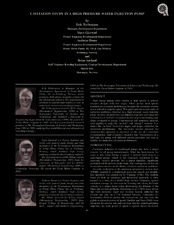| dc.contributor.other | International Pump Users Symposium (20th : 2003) | |
| dc.creator | Torbergsen, Erik | |
| dc.creator | Gjerstad, Sigve | |
| dc.creator | Hosoy, Andreas | |
| dc.creator | Aasland, Brian | |
| dc.date.accessioned | 2017-10-05T15:52:08Z | |
| dc.date.available | 2017-10-05T15:52:08Z | |
| dc.date.issued | 2003 | |
| dc.identifier.uri | https://hdl.handle.net/1969.1/164019 | |
| dc.description | Lecture | en |
| dc.description | pg. 49 | en |
| dc.description.abstract | High energy pumps often operate at high speeds to achieve compact designs with few stages. These pumps need special attention on cavitation performance because the cavitation erosion rate is related to impeller speed. This paper presents a case study of cavitation problems observed in a high pressure water injection pump. To solve the problems, two different impellers were analyzed with respect to “as-built” deviations in inlet angles and leading edge shape compared to design. Experimental and numerical methods were applied to study the “as-built” and “design” versions. It is shown that “as-built” local inlet angles and shapes controlled the cavitation performance. The necessary suction pressure for cavitation-free operation is discussed by the use of a simulated (computational fluid dynamics) inception line. Visualization on a full scale test pump with different suction pressures was used to validate the numerical cavitation performance. | en |
| dc.format.medium | Electronic | en |
| dc.format.mimetype | application/pdf | |
| dc.language.iso | en | |
| dc.publisher | Texas A&M University. Turbomachinery Laboratories | |
| dc.relation.ispartof | Proceedings of the 20th International Pump Users Symposium | en |
| dc.subject.lcsh | Pumping machinery | en |
| dc.title | Cavitation Study In A High Pressure Water Injection Pump | en |
| dc.type.genre | Presentation | en |
| dc.type.material | Text | en |
| dc.identifier.doi | https://doi.org/10.21423/R19685 | |


